![]()
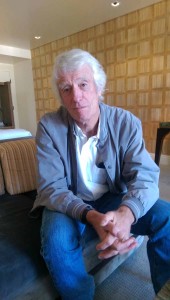
The Lionsgate release stars Benicio Del Toro as a sketchy “consultant” to law enforcement with a questionable past, Emily Blunt as an idealistic FBI agent who is enlisted by Josh Brolin, playing a member of an elite U.S. government task force, to join the escalating high-stakes border battle.
Villeneuve and Deakins, during an extended prep, storyboarded the film, stressing the precise composition of the DP’s shots, especially in Sicario’s big set pieces. Both also wanted the photography to capture the action in maximum detail, but without stamping a judgment on it. “We played with wide shots that allow the action to unfold without multiple cuts, and we used vibrant, clean colors,” observed Deakins. “The overall look is one of naturalism.”
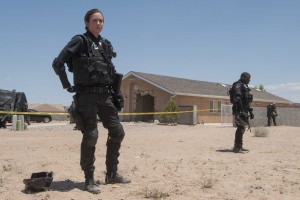
One issue: the look of the skies over the desert. “We thought we’d get bold blue skies, which may be kind of banal, but are great for continuity,” the DP noted. “But when we started shooting we ran into more intense weather than usual for the time of year, so instead there were these amazing cloud formations which were different every day,” said Deakins. He thought twice about whether or not to use these shots. “We were forced to embrace them to stay on schedule, but it turned out well, and Denny loved them.”
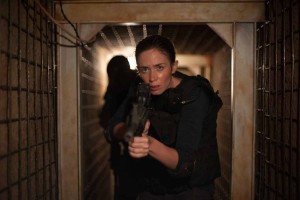 The film’s production designer, Patrice Vermette, who also collaborated with Villeneuve and Deakins on Prisoners, aimed for a gritty authenticity in his sets, which Deakins expertly captured. Vermette was inspired by the sharp opposites of the landscape, by the drained colors of the desert and, by contrast, the teeming vividness of Juarez in Mexico.
The film’s production designer, Patrice Vermette, who also collaborated with Villeneuve and Deakins on Prisoners, aimed for a gritty authenticity in his sets, which Deakins expertly captured. Vermette was inspired by the sharp opposites of the landscape, by the drained colors of the desert and, by contrast, the teeming vividness of Juarez in Mexico.
Deakins is known for his subtle camerawork (he functions as operator) and sophisticated lighting. But he faced a first-time challenge in deciding how to capture the action in the dark tunnels that stretch between Mexico and the United States and are used for smuggling huge quantities of drugs. “When I read the script, I wondered how in the hell were we going to shoot that,” he said. Consulting during prep with the director, the decision was made to use a night-vision imaging system, that illuminated the setting just enough. The SWAT team entering the tunnel is lit objectively, but once it gets inside, what is shown is from their point of view, using the night-vision device to pull off the atmospheric and memorable sequence.
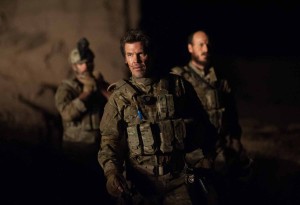
The real tunnels as they exist are quite sophisticated in the way they are built. “Once you get to the border they string lights all along the tunnel towards the exit,” said Deakins. “We basically reproduced that kind of effect. We’d shoot part of the sequence, then I would change where the bulbs were in the tunnel and moved the lighting around. By shooting it in a different way, we kind of cheated to make the tunnel look a lot longer than the actual set.”
In the penultimate scene, Del Toro’s character drives up to a brightly lit ornate mansion owned by a Sonoran drug lord. He creeps up on it then sneaks in and brutally slaughters him and also his wife and two kids while they are having dinner in a bold orange dining room. “The colors are counterpoint to the grimness. You go into this garish golden world where these kids get shot,” said the DP.
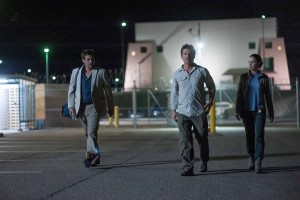 The entire scene was a challenge to light. “That was a real location. The house we used had just been built and had no lights whatever, so I had to do an elaborate job to make it all lit up from a distance,” said Deakins. “The whole sequence was tricky. When Benicio drives up to the house, I made the dark surroundings look like they were barely lit by the spill of the headlights, but I wanted to keep the blackness. I wanted it to seem like another world, with the drug baron’s house blazing in the distance.”
The entire scene was a challenge to light. “That was a real location. The house we used had just been built and had no lights whatever, so I had to do an elaborate job to make it all lit up from a distance,” said Deakins. “The whole sequence was tricky. When Benicio drives up to the house, I made the dark surroundings look like they were barely lit by the spill of the headlights, but I wanted to keep the blackness. I wanted it to seem like another world, with the drug baron’s house blazing in the distance.”
Del Toro’s expressive face “was a job to shoot—it was actually great,” said Deakins. “He loves to use the light, and in the last scene, where half of his face was in the dark, he was aware of what we were doing, and he really played into it.” Meanwhile Blunt’s character represents the overall point of view of the movie from the audience standpoint. “The film is basically seen through her eyes,” he said.
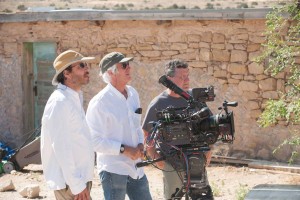 Deakins shot Sicario digitally, using the light-sensitive ARRI Alexa, his camera of choice these days. He used it first on Skyfall, the James Bond movie, which got him his third award for best film cinematography from the American Society of Cinematographers. He also has a Lifetime Achievement Award from the ASC. He now has 12 Academy Award nominations for best cinematography on films including The Shawshank Redemption, Fargo, No Country for Old Men, Prisoners and last year for Unbroken, directed by Angelina Jolie. If, as seems quite possible, he gets nominated again for Sicario, will the 13th time prove to be the charm?
Deakins shot Sicario digitally, using the light-sensitive ARRI Alexa, his camera of choice these days. He used it first on Skyfall, the James Bond movie, which got him his third award for best film cinematography from the American Society of Cinematographers. He also has a Lifetime Achievement Award from the ASC. He now has 12 Academy Award nominations for best cinematography on films including The Shawshank Redemption, Fargo, No Country for Old Men, Prisoners and last year for Unbroken, directed by Angelina Jolie. If, as seems quite possible, he gets nominated again for Sicario, will the 13th time prove to be the charm?
Up next for Deakins, he reteams with Villeneuve for a third collaboration, this time on a new version of Blade Runner, the iconic 1982 sci-fi film directed by Ridley Scott. He is currently prepping it in Montreal with the director.





